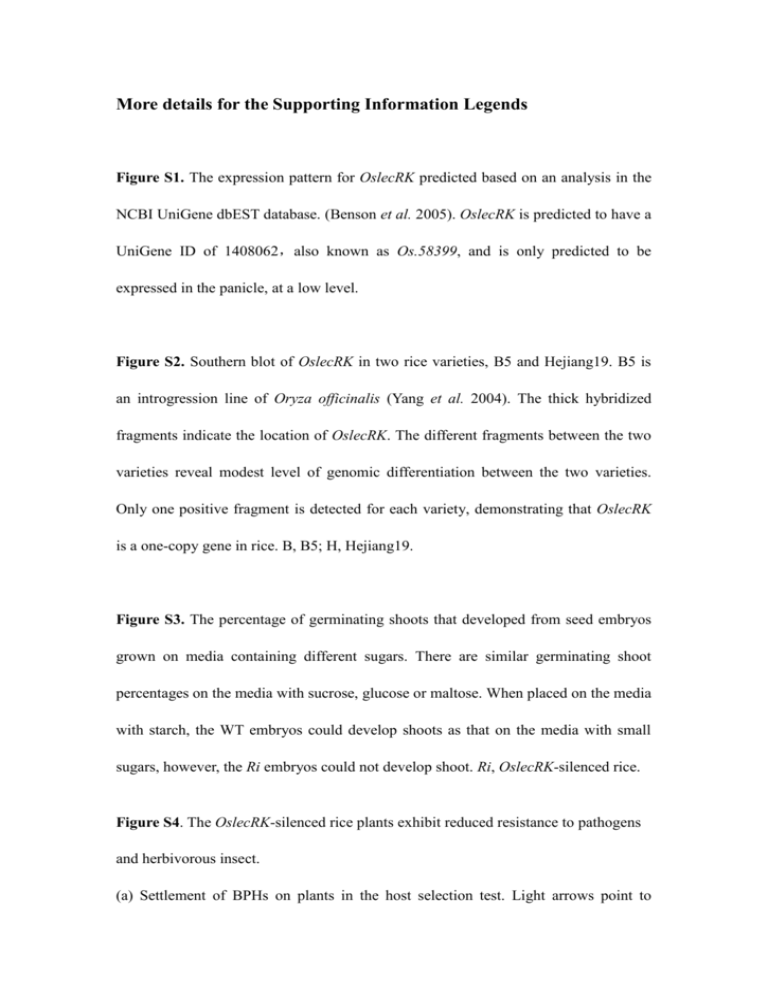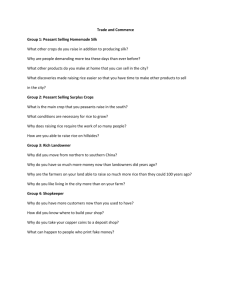tpj12328-sup-0012-Supplementarylegends
advertisement

More details for the Supporting Information Legends Figure S1. The expression pattern for OslecRK predicted based on an analysis in the NCBI UniGene dbEST database. (Benson et al. 2005). OslecRK is predicted to have a UniGene ID of 1408062,also known as Os.58399, and is only predicted to be expressed in the panicle, at a low level. Figure S2. Southern blot of OslecRK in two rice varieties, B5 and Hejiang19. B5 is an introgression line of Oryza officinalis (Yang et al. 2004). The thick hybridized fragments indicate the location of OslecRK. The different fragments between the two varieties reveal modest level of genomic differentiation between the two varieties. Only one positive fragment is detected for each variety, demonstrating that OslecRK is a one-copy gene in rice. B, B5; H, Hejiang19. Figure S3. The percentage of germinating shoots that developed from seed embryos grown on media containing different sugars. There are similar germinating shoot percentages on the media with sucrose, glucose or maltose. When placed on the media with starch, the WT embryos could develop shoots as that on the media with small sugars, however, the Ri embryos could not develop shoot. Ri, OslecRK-silenced rice. Figure S4. The OslecRK-silenced rice plants exhibit reduced resistance to pathogens and herbivorous insect. (a) Settlement of BPHs on plants in the host selection test. Light arrows point to individual insect. The image shows two plants from the WT and OslecRK-silenced lines (Ri) in a plastic bucket, with plants of the same lines at opposite positions. (b) The average number of BPH on every plant from the two rice lines. More BPHs congregated on the Ri plants than WT plants on average, that indicates the OslecRK-silenced rice plants are less resistance to brown planthoppers. (c) Rice plants with blast disease. (d) The rice resistance to blast disease scored by DSI. DSI, disease severity indices (Nishizawa et al. 1999). The pathogen M. grisea impaired the Ri plants more heavily than the WT plants. (e) Rice leaves infected with the blight pathogen. (f) The sizes of the lesioned areas on WT and Ri plants. Data are expressed as mean ± s.d.; One-Way ANOVA , * P<0.05 compared to the WT (wild-type) control. Figure S5. The characterization of the rice adf mutant. (a) The OsADF gene is composed of three exons and two introns. The rice mutant TA2-5 is produced by the T-DNA insertion next to the first exon. The T1 and A1 are primers designed according to the sequence of T-DNA and OsADF respectively, which were used in PCR with the aim to pick up the positive adf mutants. (b) Characterization of the rice adf mutants. The Upper: PCR with T1 and A1 primers. The fragments indicate the indeed T-DNA insertion into the OsADF. The Lower: RT-PCR test for the OsADF. The fragments represent the expression of OsADF, which indicates the T-DNA insertion does not cause knocking out the OsADF. (c) Characterization of the progenies of the rice adf mutant line TA2-5. Ten progenies of the rice mutant TA2-5 were chosen randomly to characterization. The Upper: PCR with T1 and A1 primers using the templates from these progenies. The fragments indicate the real T-DNA insertion into the OsADF. The Lower: RT-PCR test for the OsADF using the cDNA from these progenies. None fragments represent no expression of OsADF, which indicates the T-DNA insertion effectively leads to knocking out the OsADF. And these results also show TA2-5 is a homogenous line with T-DNA insertion into the OsADF gene. Figure S6. The resistance of the adf mutant to disease-causing pathogens. (a) The rice resistance to the fungous pathogen M. grisea scored by DSI. DSI, disease severity indices (Nishizawa et al. 1999). The rice adf mutant shows less resistant to the blast disease than the control (DJ). (b) The lesion area of the bacterial pathogen Xoo on the rice seedlings. The rice mutant adf exhibits less resistance to the blight disease than the control. In all panels, error bars indicate SD of three biological replicates. One-Way ANOVA *, P<0.05. Figure S7. Expression of OslecRK in the rice adf mutant and OsADF in Ri plants during germination and immune responses to invasions. (a) Expression of OslecRK in rice mutant adf when germination and defense responses to biotic invasions. Transcripts were reversed from three days after germination. qPCR results show no obvious difference of OslecRK expression between TA2-5 and DJ. (b) Expression of OsADF in OslecRK-silenced rice plants during germination and responses to pathogens and insect. Transcripts were reversed from three dpi after biotic attacks. Real-time PCR shows OsADF is induced obviously less in the Ri plants than that in the WT after germination and biotic stresses. Ri, OslecRK-silenced rice. In all the panels, error bars are SD from three biological replicates (One-Way ANOVA, * P<0.05). Table S1. OslecRK expression patterns predicted by MPSS analysis. MPSS signature abundances have been normalized to transcripts per million (TPM). Table S2. Accession numbers used in phylogenetic analysis. Table S3. Oligonucleotide primers used in cloning, plasmid construction and qPCR. Nucleotides in italic are protective bases, nucleotides underlined are restriction sites.






